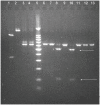HBx M130K and V131I (T-A) mutations in HBV genotype F during a follow-up study in chronic carriers
- PMID: 16080797
- PMCID: PMC1199628
- DOI: 10.1186/1743-422X-2-60
HBx M130K and V131I (T-A) mutations in HBV genotype F during a follow-up study in chronic carriers
Abstract
Background: Around 400 million people worldwide are chronically infected with Hepatitis B virus (HBV). An estimated 10% of these chronic patients develop progressive liver damage including cirrhosis and Hepatocellular Carcinoma (HCC). The HBx gene encodes a protein of 154 amino acids which is a transactivator and has been associated with HBV pathogenesis. A change in the amino acid sequences at positions 130 and 131 in the HBV-X protein (M130K and V131I) produced by T-A point mutations at the nucleic acids level has been associated with severe liver damage and HCC in patients from China and Africa. Further, such changes have been proposed as a prognostic marker for progressive liver damage and HCC. The purpose of this study was to determine if T-A mutations are present in HBV chronic carriers with genotype F (the major genotype in Costa Rica) and further, if these mutations are associated with HBV disease progression in Costa Rica HBV patients from 1972 to 1985.
Results: Serum samples from 50 HBV positive individuals were amplified and directly sequenced, 48 belonged to genotype F, 1 from genotype D and another was classified as D or E. T-A mutations were absent in 17 acute patients who recovered, but was present in 12 of 29 chronic carrier samples (42.8%), in one sample the T-A mutations were detected as early as 29 days after clinical onset of disease. In 17 carriers with available liver biopsies, T-A mutations were found in 8 sera of 13 (61.5%) classified as moderate or severe, and none in 4 biopsies with mild liver damage. However, it was not possible to demonstrate a statistical association between the presence of T-A mutations and moderate/severe liver damage, using a Fischer exact test, 1 tail, p = 0.05. In 4 patients HCC was diagnosed, and 2 of them presented the T-A mutations in their sera.
Conclusion: T-A mutations were found in HBV genotype F in chronic carriers but not in patients who recovered from acute infection. These mutations could be developing early during infection although the possibility of infection with the mutant virus could not be excluded. More studies are necessary to establish if the T-A mutation can be used as a prognostic marker for severity of liver disease in patients infected with HBV.
Figures



Similar articles
-
Comparison of full length sequences of hepatitis B virus isolates in hepatocellular carcinoma patients and asymptomatic carriers of Korea.J Med Virol. 2005 Jan;75(1):13-9. doi: 10.1002/jmv.20230. J Med Virol. 2005. PMID: 15543574
-
Profile, spectrum and significance of hepatitis B virus genotypes in chronic HBV-infected patients in Yunnan, China.Hepatobiliary Pancreat Dis Int. 2008 Jun;7(3):271-9. Hepatobiliary Pancreat Dis Int. 2008. PMID: 18522881
-
Hepatitis B virus genotypes and hepatitis B surface antigen mutations in family contacts of hepatitis B virus infected patients with occult hepatitis B virus infection.J Gastroenterol Hepatol. 2009 Apr;24(4):588-98. doi: 10.1111/j.1440-1746.2008.05727.x. Epub 2009 Jan 13. J Gastroenterol Hepatol. 2009. PMID: 19207682
-
Natural history of chronic hepatitis B: what exactly has REVEAL revealed?Liver Int. 2012 Oct;32(9):1333-41. doi: 10.1111/j.1478-3231.2012.02805.x. Epub 2012 Apr 17. Liver Int. 2012. PMID: 22510145 Review.
-
X region mutations of hepatitis B virus related to clinical severity.World J Gastroenterol. 2016 Jun 28;22(24):5467-78. doi: 10.3748/wjg.v22.i24.5467. World J Gastroenterol. 2016. PMID: 27350725 Free PMC article. Review.
Cited by
-
Mutations in pre-core and basal-core promoter regions of hepatitis B virus in chronic HBV patients from Golestan, Iran.Iran J Basic Med Sci. 2014 May;17(5):370-7. Iran J Basic Med Sci. 2014. PMID: 24967066 Free PMC article.
-
Hepatitis B virus infection in Latin America: a genomic medicine approach.World J Gastroenterol. 2014 Jun 21;20(23):7181-96. doi: 10.3748/wjg.v20.i23.7181. World J Gastroenterol. 2014. PMID: 24966588 Free PMC article. Review.
-
Mutations in Hepatitis-B X-Gene Region: Chronic Hepatitis-B versus Cirrhosis.J Clin Diagn Res. 2017 Mar;11(3):OC31-OC34. doi: 10.7860/JCDR/2017/22570.9498. Epub 2017 Mar 1. J Clin Diagn Res. 2017. PMID: 28511432 Free PMC article.
-
A novel mutant 10Ala/Arg together with mutant 144Ser/Arg of hepatitis B virus X protein involved in hepatitis B virus-related hepatocarcinogenesis in HepG2 cell lines.Cancer Lett. 2016 Feb 28;371(2):285-91. doi: 10.1016/j.canlet.2015.12.008. Epub 2015 Dec 17. Cancer Lett. 2016. PMID: 26706415 Free PMC article.
-
BAsE-Seq: a method for obtaining long viral haplotypes from short sequence reads.Genome Biol. 2014;15(11):517. doi: 10.1186/PREACCEPT-6768001251451949. Genome Biol. 2014. PMID: 25406369 Free PMC article.
References
Publication types
MeSH terms
Substances
LinkOut - more resources
Full Text Sources

